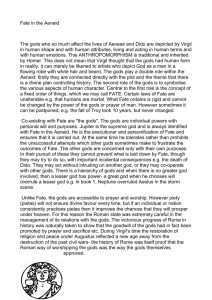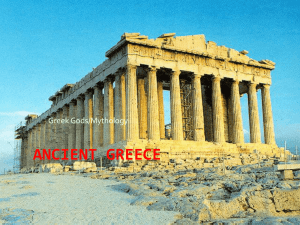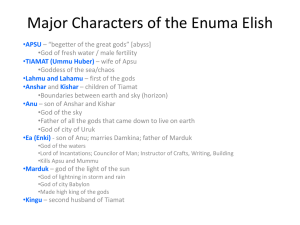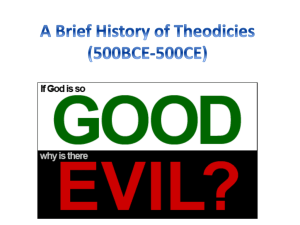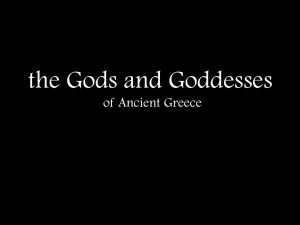The Fates and the Roman gods
advertisement
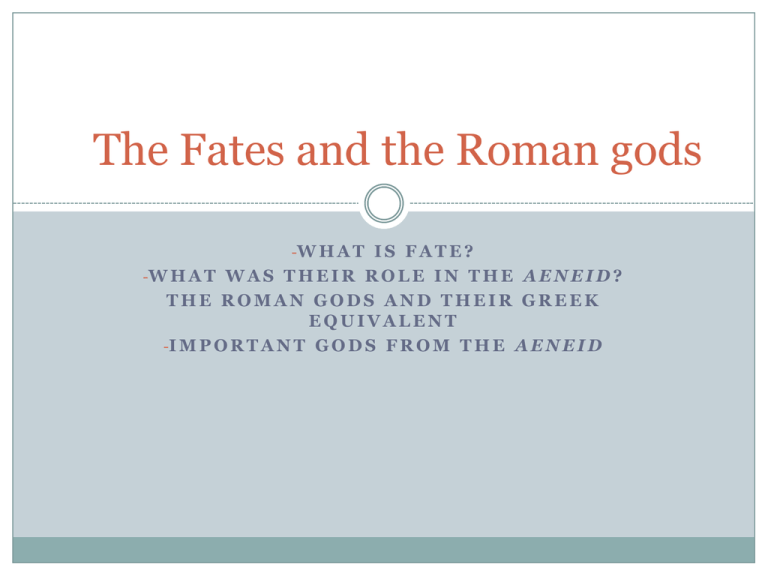
The Fates and the Roman gods -W H A T I S F A T E ? -W H A T W A S T H E I R R O L E I N T H E A E N E I D ? THE ROMAN GODS AND THEIR GREEK EQUIVALENT -I M P O R T A N T G O D S F R O M T H E A E N E I D Quiz Juno is angry at Aeneas because he insulted her by choosing Venus over her. T/F When was the Aeneid written? When did the Trojan War take place? What are the two main historical elements in the Aeneid? What historical people are Aeneas and Dido compared to? Give a brief definition of Fate using your own knowledge. What is Fate? Fate “ a fixed order of things” . Fate means that there are unchangeable laws and inevitable outcomes. It was fate that Troy would fall and that Aeneas would be the founding father of the Roman race. Neither the gods or the humans can change what Fate has decreed. More information on Fate…. Virgil’s philosophical background –the Stoics “conceived the whole world as subject to a single controlling purpose”. The Aeneid reflects a feeling about the supernatural which reflects Roman national sentiment (that they were destined to be a great empire). It also vindicates Roman religion (that Fate and the gods were an integral part of Roman society). QUIRKY QUESTION OF THE DAY Which North African seaport's name is Spanish for white house? Clue: a 1943 film with Humphrey Bogart and Ingrid Bergman was called this. CASABLANCA Roman gods Read the introduction by Taylor (The Aeneid of Virgil) and answer the following questions: Why did the Greeks and Romans create myths? Who is Jove? Give the Greek equivalent of Pluto and Juno. Where did the gods reside? What are Neptune’s personality traits and what natural phenomenon do they explain? Explain what “a sop to Cerberus” means. What was Tartarus? How was Mercury entangled in the Trojan War? How does Jupiter react to the abduction of Helen? What is Taylor’s interpretation of the Aeneid? Activity Present the following information in a concept map, bullet points or a series of pictorials. The Roman gods Important things you NEED to KNOW! Anthropomorphism – depicting the gods in human form. Necessary for working the gods into the text. Hierarchal system – Jupiter is supreme, head of the pantheon (27 B.C.) and the other gods below him have smaller functions. For many of the gods their actions are selfish and in their own interests. These actions have an impact on the humans. Example: Juno and Aeneas or Venus and Dido. Their actions explain natural events like Aeolus’ storm which was calmed by Neptune. Unlike Fate people can appeal to the gods through ritual and prayer for a more favourable outcome. Fortune and Fate work together behind the scenes. The Roman gods cont. Aeneas was required to save the gods Vesta, Lares and Penates from Troy and bring them to Italy so they could be established there. Some gods already existed there. Penates :a smaller deity. Looked over houses (like the Greek Hermes). The statues were placed in the inner most part of the house and known as Penates. In Book II, one is noted next to an altar in King Priam’s palace. Lares: looked after the family. Lar familias – spiritual ruler of the home. Paterfamilias – physical ruler of the home. The Roman gods and their Greek counterparts Go through the list of names provided and highlight/underline the gods (especially the 12 Olympians: Jupiter, Juno, Venus, Vulcan, Neptune, Pluto, Vesta, Apollo, Diana, Mars, Mercury and Minerva). Give the 12 Olympian gods their Greek names. Zeus, Hera, Aphrodite, Hephaestus, Poseidon, Hades, Hestia, Apollo, Demeter, Ares, Hermes and Athena.
